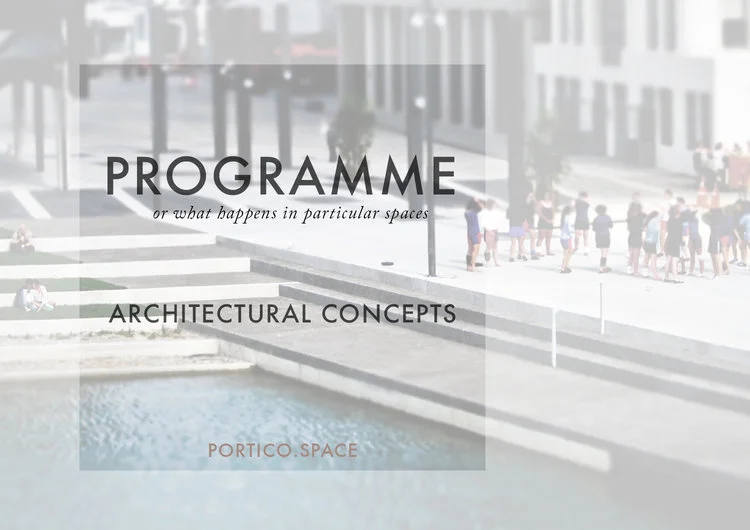5 things you won't get taught at architecture school (THE WORK EDITION)
Last week I tackled the question of "What do you learn in architecture school?"
In that post (which you can read here) I covered a vast list of subjects, topic areas, and themes you'll usually learn in the process of getting your architecture degree. My answer was so broad, in fact, that some people have asked: well, what don't you learn at architecture school?
So this week I've been thinking about just that:
the things you don't learn at architecture school.
The truth is, there are quite a few things you don't get taught at architecture school. You can't, and shouldn't expect, to learn everything there ever was to know about architecture in a period of about 5 years. At least for me, half the fun of being involved in the field of architecture is the continual learning, the everyday problem-solving, and the ongoing sense of discovery.
In many ways, the field of architecture is so broad that the learning relates to many other professions: law, management, graphic design, psychology, environmental science, engineering and so on. But while architecture school grapples with this breadth, it sometimes only lightly touches on some other fundamental aspects of what building a life with architecture might mean.
THE UBIQUITOUS LIST
Lists of things you don't learn at architecture school are pretty popular on the internet. I've certainly clicked through to a fair few in the past: 101 things on ArchDaily, 10 things on Architizer, 11 more on Arch20.
They're often humorous, yes. But what you'll also notice is that these kinds of articles usually offer a long, long list made up of sound bites and pretty obvious things you might not learn at architecture school, but you'd hope you'd learn by just operating in the world as an inquisitive human being!
So I didn't want to just add to that whirlpool of consumable lists. I wanted to go deeper than that for you. To uncover not only what you don't get taught, but why architecture school might skew some of your expectations, and what you can do to get the better of the situation.
So to address some of those things, I'm bringing you a new series: 5 things you won't get taught at architecture school. Each edition in the series will cover a different theme.
This week...
5 things you won't get taught at architecture school: the work edition.
These learnings are about:
how you work;
what good work looks like;
what real productivity means; and
and how to understand (and begin to shape) your role in the workplace.
This first post in the series is about work and the workplace.
Not the nitty gritty of what you do day-to-day as an architect, but the bigger picture of what work really is. While it's written from experience in architectural practice, the lessons are application to almost any professional situation you might find yourself in in the future.
HOW WORK WORKS
Architecture school is often so all consuming that it can be difficult to give your self space to think about the big picture, and how what you're learning, doing, and making will help you in a life after architecture school.
One part of that life? Work.
Whether you go into a job at an architecture firm or not, HERE ARE 5 THINGS
you probably want to know before you're in the hot seat.
1. Speed isn't the most important thing
So often, as graduates we think that our main goal in practice is to complete the task we're given as soon as we possibly can. We want to tick things off the list, prove our value and efficiency.
We've all done it - nodding along while our manager or team leading is explaining some design changes, and then running back to our desk to click the mouse furiously and - sometimes unthinkingly - moving walls and floors left right and centre. Guilty.
And fair enough - because Architecture School often feeds into this mindset
With deadlines looming, at architecture school you need to work hard and fast. You quickly learn that it's most efficient to only work on the parts of the project you will actually see in your presentation - and at the time, that's smart! You figure out all sorts of tricks to fudge the areas you aren't sure about.
But without a doubt, in the need for speed, you sacrifice things. You overlook accuracy, throw out any idea of precision, and sometimes probably overlook key areas or even leave things out completely - all because you're in a rush.
But wanting one part of your project to look good right now is a trap.
In real life, architecture is very much a process.
Long-term accuracy and precision are far more important than speed.
Deadlines exist, but always as stepping stones to the next stage. Remember the end goal is (usually) a built thing, not your drawing. The process of going from the brief to a completed building takes a long, long time.
In a render for a presentation at architecture school, it doesn't matter if a gap that is supposed to be 10mm is actually 9.579087mm in your model. Similarly, no one will notice when you pin up that the section isn't completely true to the plan, or that you've not scaled your site plan perfectly.
In reality, though, these things matter. And they matter a lot.
For a project to run as smoothly as possible,
your work needs to be as precise as possible.
It makes sense, right? If your work isn't precise, or if things are missing, you're costing someone else their time to fix it up. Best case is that your manager picks up the error and is able to fix it - or instruct you to. Worst case? Your inaccuracy makes it all the way through the drawing set, goes to site and becomes a major issue during construction. Either way: it can be a pretty embarrassing situation to find yourself in, not to mention making you a risk to the practice.
Of course, you shouldn't take forever to complete things either - or worse still, never complete the tasks you are set. You will still overlook some times, or draw something slightly incorrectly. It's pretty much impossible to put together a perfect set of drawings - even for seasoned professionals!
But to start with, your focus should be on doing your work well. Learn to use the resources available to help you do this. And if you're not sure, ask, rather than making something up so you can claim it as finished. Really - don't be afraid to ask.
As tasks and processes become habitual, you'll be able to do things well, with precision, quicker. Speed comes with experience - but even the experienced don't sacrifice precision for speed.
By the way, if you're unsure about the difference between Accuracy and Precision:
Precision is how perfectly your lines, points, and words relate to each other.
For example: Does the section match up with the plan? Are the measurements the same as what is drawn? Are things drawn to a whole number, or have you rounded because the drawing is off by a little bit? Are horizontals truly horizontal?
Accuracy is how close your representation (drawing, model, text) is to reality.
For example: is the wall type that is drawn going to be the exact way it will be built? Are the dimensions accurate to what will be built on site? Is the position on the site relative to North correct?
It's a pretty good distinction to be able to make as an Architect!
Accuracy is achieved over the length of a project, as you get closer and closer to the 'real thing.
Precision, on the other hand, happens everyday, every time you draw, model, or write something.
2. not all tasks have equal value & not everything HAS to be done now
“Knowing where to start, what the end goal is, and how to manage all the new things that get put on your plate daily can be the key to your success. ”
That's right. When your manager asks you to do some work on a new project, they often don't actually mean "Drop everything and finish this immediately."
This can be a tricky one.
the student strategy
At university, it's usually pretty straightforward. The much mythologised strategy of a typical architecture student goes something like:
Leave all work until a couple of days before it is due; then
Work exclusively and intensively on one project at a time;
Hand in and the very very last minute;
Don't work on the next one until it's nearly due; and
Repeat.
No, it's not really a sustainable system, but somehow people do manage to make it work for themselves at architecture school. There's a certain buzz to the studio as a hand-in approaches and everyone kicks up a few gears. And in some ways, it's good to know you can get things done fast when you need to. Find out more about workload and time management at architecture school here.
in the workplace: the fresh graduate
When you start working, you'll often be drip-fed tasks, so you only have one or two things to focus on at a time. This simplifies things a whole lot - by clarifying the scope of the task, what completion looks like, and making it super-easy to know what you should be doing at any one point in time.
in the workplace: the real deal
As you become more embedded in your projects, and are given more responsibility, you'll end up with to-do lists upon to-do lists that run on for pages. Making lists is a great base strategy, but at this scale, even they can become overwhelming! Add to that the daily distractions and you're setting yourself up for a disaster. I've seen so many co-workers distracted from their real, important and valuable work because they are trying to answer every email as soon as it comes in, or they're sucked in to a particular client's desires.
In this environment, knowing where to start, what the end goal is, and how to manage all the new things that get put on your plate daily can be the key to your success. This is something you need to figure out for yourself.
You need to learn:
To quickly evaluate tasks;
To prioritise your tasks;
To re-focus on tasks one at a time;
AND THEN...To complete things.
That might mean sometimes standing up and saying 'Yes, I can do that, but I won't be able to work on it until Thursday.' It might mean making sure the implications of switching tasks are obvious to your manager. Or, it might mean stopping working on something that won't really matter in the big picture.
You'll get better at knowing the best course of action with time.
But if you're just starting out, want my advice?
When you're asked to do something, make sure you know the point of the task, and approximately how long it is expected to take. Don't just jump in - spend time understanding the task and evaluating your overall workload first.
Oh, and think about using a task management system to log all the things you need to do, and prioritise or even delegate them! Personally, I recommend Asana. You can find out about Asana, and my other time management recommendations, by grabbing a free pdf list of tools here.
3. good systems will save you
“One of the best things about systems is that when you’re asked to do something, you can confidently say “Yes, that will take me 5 minutes.” And then it does.”
At university, a new project often means a fresh start: new ideas, new research, new layout, new materials, new presentation techniques, new fonts. In fact, a good part of your learning comes from trying new things or righting past mistakes, so the process rewards doing things differently.
But in the workplace, you don't have to start everything from scratch, every time. In fact, it's better for both the business and your sanity if you don't!
Let's be honest, there's a lot of repetition at work. Either you're doing the same tasks on a new project, or you're re-doing, modifying, or pre-presenting work for the same project. That's what happens when you begin to specialise and master your chosen field.
But if you're anything like me, you probably hate doing things twice.
I know when you're under pressure it's tempting to do things the quick way, even if it means taking shortcuts, over-writing previous work, or just making up your own way of doing things. But often it isn't actually that much quicker. And if you have to change anything, or come back to that part of the project later, you've often just made a whole lot of problems for yourself.
The way to get around this is to
first: put systems in place,
and then: stick to them!
I know when you're under pressure it's tempting to do things the quick way, even if it means taking shortcuts, over-writing previous work, or just making up your own way of doing things. But often it isn't actually that much quicker. And if you have to change anything, or come back to that part of the project later, you've often just made a whole lot of problems for yourself.
The way to get around this is to
first: put systems in place,
and then: stick to them!
And when things go wrong:
You know where to look to fix them;
You can identify where the problem might have started;
You can update or correct one aspect and it will correct all the other instances for you.
Good systems means:
You do same things the same way every time, so it's fast;
You save things in the same way every time, so it's easy to find things;
Someone else can pick up your project and make sense of it!
Systems at work
One of the best things about systems at work is that when you are asked to do something, you can confidently say "Yes, that will take me 5 minutes," and watch the astonishment on everyone's face as you change 50 apartment plans and sections and print them out there and then. Knowing how you will carry out a task also makes it much easier to jump into actually doing the work.
Usually when you go into a workplace, your focus should be on slotting in to and using the existing systems.
This should cover everything from:
Organising your drawings and models;
Filing your emails and notes correctly
Following office procedure for CAD layers, families, and blocks;
Using as many template and automation feature as you can.
You should keep notes of where a system didn't work, times when you wished it worked better, or other ways you think it could be more efficient. Once you get into the swing of things, you can start to implement these changes and come up with even better systems.
preparing your own systems now
But you don't need to wait until you get into the workplace to start! The only thing holding you back is that no one will be pushing you to have better systems at university!
Preparing your own systems to save you time and stress at university might mean:
Developing templates for site analysis and precedent research;
Setting up your favourite fonts as styles in Microsoft word, so you can get straight into writing;
Figuring out how to keep track of references from the beginning;
Having a folder system for your different papers and projects;
Having a naming system for saving files - especially as it gets towards the end of a project (otherwise you'll end up with things like designfinalfinal3.psd and designfinalactual.psd)
Automatically backing things up.
4. Money, money, money.
At architecture school, money rarely, if ever, comes into the picture. If it does, it's often only in an abstract sense - you might work on something which is 'low-cost' or think about generating a 'profit' for developers of an apartment block.
In practice, money is at the forefront - and if it's not explicitly part of the conversation, you know it's sitting in the wings, waiting to make an appearance. This might seem crude, but it's actually a very important part of what motivates, supports and enables architecture to happen.
I often talk about Architecture being a 'journey' or a 'practice' - and this is thinking about architecture from your perspective as a creative individual. But the reality of how this plays out is tied to economic, political and societal systems. Your journey is linked to, supported by, and built on these underlying structures.
Money at work
In practice, there are 3 key types of money to get your head around.
MONEY #1: Your take home pay
Your money is what you take home as compensation for the work you do.
At first, after so much time studying, it seems exciting to get paid at all, but that can soon turn into mild depression as you realise how much work you're doing for often fairly low pay.
The profession as a whole has an issue with compensation - and has long been strategising about how to get the value of the work we do more appreciated and understood in the public realm. This is something you can help with, but probably can't fix alone.
The other part of the issue - how much you are paid as an individual within the system, is something you need to think about
Let's be honest - no one really cares about your pay except you.
You have to make others care, bring it into the conversation, and make a case for yourself. You need to chase opportunities, make opportunities, and sometimes, you'll have to make tough decisions.
But you should also realise that your salary is only part of the package - life pays you in other ways too.
MONEY #2: the business.
In the broader picture, Architecture is a service, usually provided by architects, and which is usually reimbursed. Typically the aim of any architecture practice is to make money, to support the team of architects to be able to keep doing architecture in the future.
This isn't just about making a profit, but it's also about supporting the costs of supplying that service, from the staff to the photocopier to insuring against risk, and the cost of ensuring stability in the future.
The business relies on clients requesting services. Unfortunately, because construction requires large investments for little direct return, and architecture is still often seen as a 'nice-to-have-extra', any business in the construction industry, and architectural services in particular, are very exposed to fluctuations in the wider economy.
MONEY #3: the project budget.
Your client's money is more commonly known as the budget. This is a certain amount that they are prepared to spend to achieve what is often a long-held personal dream, an investment in their company image, or a property development venture.
The budget drives or underpins most design decisions, but that isn't to say that you're always trying to make the cheapest decision possible. There are a number of factors, including initial cost, sustainability, ease of construction, and aesthetic value that come into play.
But, at the end of the day, the project won't go ahead if it doesn't achieve certain aims at a certain cost. A large part of the design work you do is managing those cost expectations. To do so, you need to be able to understand and talk about money.
5. Communication IS AN ART
At architecture school, there is a lot of emphasis on the crit: when you stand up and present your work to a panel of visiting critics(otherwise known as a 'jury'). This means you put a lot of thought and effort into learning to polish your drawings, recite your concept and precis, and then defend your work against interrogation in question time.
Sure, you need to communicate your project to your tutor and maybe your friends as your are developing it, but the main emphasis is on how you will speak about it and pin up your images in a polished, final, and convincing way.
Don't get me wrong - all this learning is spot on and super useful, especially for those who suffer from self-doubt or dislike speaking in front of others.
But privileging this kind of communication over others doesn't quite reflect real life. In reality, the rules and techniques aren't quite as hard and fast.
The Art of Communication at Work
In the workplace, communication is much, much more subtle, and much, much more continuous. It's about words, yes, and about images, but it's also about eyebrow raises, scribbly sketches, and knowing how to tune your pitch.
On a day-to-day basis, you need to be empathetic, understand the moods and pressures of the office and your co-workers, and choose what you say and how you say it. It's not so much about polishing your presentation as it is about being malleable with it. You need to build the situations so that your ideas can be received the way you want them to.
When discussing projects with consultants and clients, things sway more and more into the non-verbal. Being able to sketch, fold a bit of paper, or find a reference image is key. And sometimes you need to be able to be persuasive and defend your idea, but sometimes you need to be able to think on your toes and change your tack.
You can find more about using drawing as a communication tool here.











